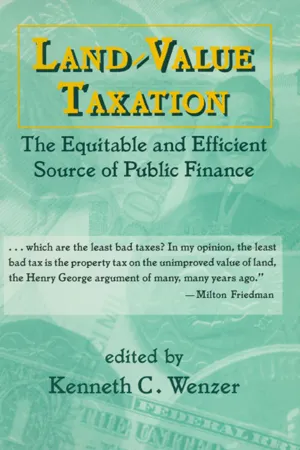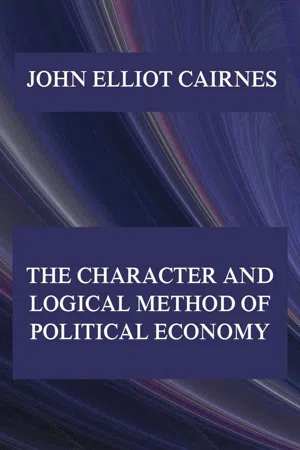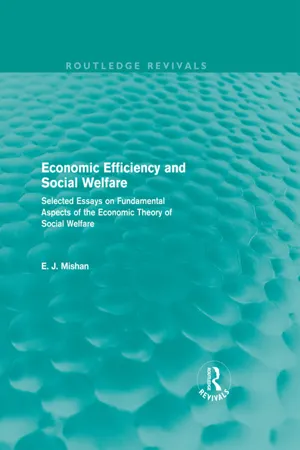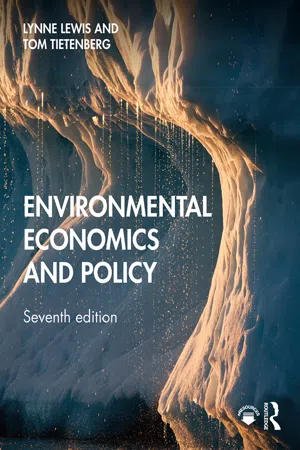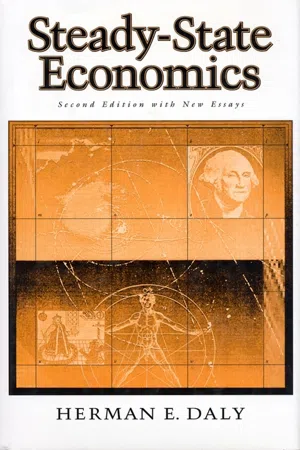Business
Economic Rent
Economic rent refers to the payment made for the use of a resource that exceeds the minimum amount required to keep the resource in its current use. It is the surplus income earned by a factor of production beyond what is needed to keep it in its current use. In business, economic rent can arise from factors like location, natural resource availability, or unique skills.
Written by Perlego with AI-assistance
Related key terms
Related key terms
1 of 4
Related key terms
1 of 3
8 Key excerpts on "Economic Rent"
- eBook - ePub
- Hong Sheng, Pu Qian(Authors)
- 2019(Publication Date)
- WSPC(Publisher)
Figure 3.1 ). Absolute rent is the difference between having and not having the factor of production. Economic Rent is the difference between a value produced by one factor of production and the cost needed to bring that factor into production. This is equivalent to absolute rent.Figure 3.1.Diagram of land rent.Note: Q1 is the quantity of maximum supply of resources.People will soon discover that it is possible to create rent through means of human will. For instance, monopoly created by technological innovation can create rent through controlling the quantity of production or through pricing. Another way is by legal or administrative means to restrict the quantity of a certain resource or quantity supplied of a product; the former is productive and the latter is non-productive.Another type of rent is the difference in value between best and secondbest usage of a resource. Compared with the above concept of rent, this is a choice between different uses of the same resource. With different usage, there will be different demand function and different supply function, and the return will also be different. For instance, the demand function of a singer performing in a bar differs from that of a singer performing in an opera house, and the number of competent singers is also different. The difference between the equilibrium prices of the two different usages is called rent.There are different numbers of singers for different purposes, therefore, a different supply function. The difference in supply function determines the rent generated by the different supply of resources. The difference between this and Economic Rent is that Economic Rent depicts the value differences between having a means of production and not having it (equals to zero). While the rent we discussed above is the differential between usages of the same means of production, where the second best usage value is not zero (see Figure 3.2 - eBook - ePub
Land-Value Taxation
The Equitable Source of Public Finance
- K.C. Wenzer(Author)
- 2016(Publication Date)
- Routledge(Publisher)
14 Fred E. Foldvary The Ethics of RentRent is a source of public revenue that does not engender any economic damage. But is it morally right to take revenue for government from only one class of owners? And is there a conflict or is there harmony between what is morally right and what is economically sound?What Rent IsThe term “rent” has several meanings. The classical meaning is the return on land as a factor or resource of production. Since it was recognized that landowners as landowners receive rent without having to do anything for it but have title to land, the term became extended to “Economic Rent,” meaning any income beyond that which is needed to put a factor into production. More recently, the term “rent seeking” was introduced to mean the Economic Rents taken by whoever receives government privileges, subsidies, and other transfers.1 Popularly, “rent” also means a payment for the use of property owned by others, as in renting a car or apartment; a synonym for this meaning is “rental.” Unless otherwise qualified, the term “rent” in this chapter refers specifically to land rent. “Economic Rent” will take the definition just given, and “rental” will refer to payments for the use of any property and (as discussed below) to land rent due to the presence of public or civic works.“Land” in economics includes all natural resources, everything prior to alteration by human action. The narrower meaning is the solid surface of the earth. Here, “land” will refer to economic land, which embraces all natural resources and opportunities, including those not traditionally associated with land. The various forms of land include sites on the surface of the earth (whether solid or water); all minerals, oil, water, virgin soil, and other material resources beneath the surface; air space; the spectrum of radio and television; the earth’s wildlife, the genetic stock of the planet (all the genetic information present in life); and usable locations in outer space, such as satellite orbits. - eBook - ePub
Urban Land Rent
Singapore as a Property State
- Anne Haila(Author)
- 2015(Publication Date)
- Wiley-Blackwell(Publisher)
Throughout its history, starting from the works of Adam Smith and David Ricardo to those of Jevons, Marshall, William Alonso and David Harvey, rent theory and the concept of rent have changed, and the ensuing controversies split scholars into different schools. Classical economists regarded rent as a separate and important concept, whereas neoclassical economists generalised the concept of rent. Urban economics later modified the concept of rent and connected it to individual utility. To understand the concept of rent within property rights theory, I now turn to examine how the concept of rent was extended and generalised in mainstream economics.Extending the Rent Concept
David Ricardo defined rent as ‘that portion of the produce of the earth which is paid to the landlord for the use of the original and indestructible powers of the soil’ (Ricardo [1817] 1974: 33). This definition comprises three parts: rent is the produce of the earth, is paid for the use of the earth, and is paid to the landlord. Three rent theory traditions can be identified on the basis of these three aspects of rent: mainstream economics focusing on land as a resource, urban economics on land use, and the Marxist tradition of the landlord–tenant relation.Ricardo's definition that rent is the produce of the earth implies that land is unique, that land has special characteristics. This became a divisive issue among economists. On the one hand, land economists (Richard Ely) and urban economists (Edwin Mills and William Alonso) regarded land as unique and special. Among the special characteristics of land are immobility, fixity in place, possibility for alternative uses, and land as a necessary condition for all activities. On the other hand, there gradually developed the idea that there is nothing special about land. Land is simply one factor of production along with labour and capital. The concept of rent then became extended (to other factors of production) and generalised (capital and labour can also produce rent). Rent became understood simply as surplus produced under certain market conditions. There is nothing unearned or immoral in rent and, most importantly, rent from an alternative use came to be regarded as a cost. - eBook - ePub
Vision and Calculation
Economics from China's Perspective
- Sheng Hong(Author)
- 2020(Publication Date)
- Palgrave Macmillan(Publisher)
technological innovation , rent can be created by controlling production or directly setting the price. Another way is to impose a mandatory restriction on the supply of a resource or product through legal or administrative means. Of course, the former is productive, and the latter is unproductive.Another concept of “rent” is the difference between the value of a resource’s optimal use and suboptimal use. The difference from the previous concept of rent is that it is a choice between multiple uses of resources—different uses, different demand functions, different supply functions, and different incomes. For example, the demand function of a singer singing in a bar is different from that in an opera house, and the number of competent singers is different. These differences lead to different equilibrium prices , and the difference between the equilibrium prices for two uses is rent.The number of singers for different purposes is different, and the supply function is different. The rent depends on the supply of resources. Economic Rent is the difference between the value obtained by using the resource and that without it, and the latter is obviously zero. However, unlike Economic Rent, the “rent” here is the difference between the value of the best use and the value of the second-best use, and the latter is not zero. See Fig. 12.2 a.Fig. 12.1Land rent. Note: Q1 is the ceiling of the resource supplyFig. 12.2(a ) Singer’s Supply and Demand Function in Bar. (b ) Singer’s Supply and Demand Function in OperaEven though they are different, the concepts of these two types of rents share common characteristics. First, they are all caused by the quantity limit of the resources supply. Second, they also affect the quantity of products or services produced by the resources. Therefore, the two concepts of rent can be generalized into one concept of rent. - John Elliot Cairnes(Author)
- 2018(Publication Date)
- Jazzybee Verlag(Publisher)
The object of a theory of rent is to explain the fact of rent, and the conditions which determine its rise and fall. In order, therefore, to judge of the theory, we must form a clear and definite idea of the fact of which it is designed to afford the explanation. The fact, then, which the theory of rent is adduced to explain is the existence in certain branches of industry of a permanent surplus value in the product, beyond what is sufficient to replace the capital employed in production, together with the usual profits which happen to prevail in the country. Thus a farmer, after replacing the circulating stock employed in cultivating his farm with the usual profits, and reserving, besides, interest on such capital as he may have sunk in outlay of a more permanent kind, finds that the proceeds of his industry still leave him an element of value. This element of value, if he be merely the occupier of his farm, goes to his landlord; or, should he, during the continuance of his lease, be able to retain a portion of it, he will at all events on its termination be compelled by the competition of other farmers to hand it over to his landlord. On the other hand, if the farmer be himself the proprietor of the land which he tills, the sum in question will of course accrue to him along with his other earnings. In the same way the patentee of a successful invention, on selling the produce of his industry, finds himself also in possession of an element of value over and above what is sufficient to replace the cost of production, together with the ordinary profits. Now it is this surplus value, whether derived from agricultural or from manufacturing operations, whether retained by the producer or handed over to the owner of the productive instrument, which constitutes 'rent' in the economic sense of that word, and the existence of which is the fact to be accounted for.You will observe, I say 'in the economic sense of the word,' because this is one of those cases in which the necessity under which political economists are placed of using popular phraseology in scientific discussions has led to much confusion of ideas and perplexity of reasoning. The term 'rent' is in popular language applied to the revenue which the proprietor of any article derives from its hire. Such a revenue, however, may owe its existence to different causes. The rent, e.g., which a landlord receives from a farmer for the hire of his land, is derived from a surplus value in the proceeds of the farmer's industry beyond what will cover the expenses and profits of his farm. On the other hand, the building-rent of a house represents no surplus value of this kind. It is not anything in addition to the ordinary profit, but is simply the ordinary profit or interest which the builder of the house receives on the capital which he has sunk.- eBook - ePub
Economic Efficiency and Social Welfare (Routledge Revivals)
Selected Essays on Fundamental Aspects of the Economic Theory of Social Welfare
- E. Mishan(Author)
- 2013(Publication Date)
- Routledge(Publisher)
9 as a measure of rent is, again, clearly relevant: the decision to employ a certain piece of land, for example, in one use rather than another is determined by a comparison of the resulting rents.Such instances as these, however, are properly regarded as examples of Economic Rent as previously defined [12], notwithstanding that they are apparently derived with reference to the production function and seemingly without reference to people’s preference functions. The compensating variation definition of rent is the maximum sum a factor-owner would pay to have the full benefit of a rise in the price of his factor. The equivalent variation definition is the minimum sum he will accept to forgo the benefit of the price rise. If the income effect - or, more accurately, the welfare effect - is zero, either definition produces exactly the same measure. And if the factor-owner is concerned only with pecuniary advantage, this measure will be identical with the area above the supply curve reckoned as a sum of money. All of the Marshallian quasi-rent is to be imputed to the owners of specific capital equipment (at least in riskless situations). Ricardian rent is obviously to be imputed entirely to the owners of non-marginal land.IV
The area above the long-period supply curve of an industry appears to offer, for policy purposes, the more significant measure of producer’s surplus. Certainly it would seem that the criterion suggested by Hicks in 1940 [5], that (assuming universal perfect competition) consumer’s surplus plus producer’s surplus positive10 would justify the introduction of a new commodity, implies a long period supply curve. If, in a limiting case, we took consumer’s surplus to be zero, the criterion that producer’s surplus be positive could be compared with the familiar investment criterion thatPVi (A)be positive - wherePVi (A)represents the present value of the A stream of net returns discounted at i . The positive producer’s surplus would then be measured as the area above the long-period supply curve, an average curve that includes all capital charges.11 - eBook - ePub
- Lynne Lewis, Thomas Tietenberg(Authors)
- 2019(Publication Date)
- Routledge(Publisher)
Since the area under the price line is total revenue, and the area under the marginal cost (or supply) curve is total variable cost, producer’s surplus is related to profits. In the short run when some costs are fixed, producer’s surplus is equal to profits plus fixed cost. In the long run when all costs are variable, producer’s surplus is equal to profits plus rent, the return to scarce inputs owned by the producer. As long as new firms can enter into profitable industries without raising the prices of purchased inputs, long-run profits and rent will equal zero.Scarcity rent
Most natural resource industries, however, give rise to a form of rent, which is not eliminated by competition, even with free entry. This producer’s surplus, which persists in long-run competitive equilibrium, is called scarcity rent .David Ricardo was the first economist to recognize the existence of scarcity rent. Ricardo suggested that the price of land was determined by the least fertile marginal unit of land. Since the price had to be sufficiently high to allow the poorer land to be brought into production, other, more fertile land could be farmed at an economic profit. Competition could not erode that profit because the amount of high-quality land was limited and lower prices would serve only to reduce the supply of land below demand. The only way to expand production would be to bring additional, less fertile land (costlier to farm) into production; consequently, additional production does not lower price, as it does in a constant-cost industry.Externalities as a source of market failure
The concept introduced
Exclusivity is one of the chief characteristics of an efficient property rights structure. This characteristic is frequently violated in practice. One broad class of violations occurs when an agent making a decision does not bear all of the consequences of his or her action.Suppose two firms are located by a river. The first produces steel, while the second, somewhat downstream, operates a resort hotel. Both use the river, although in different ways. The steel firm uses it as a receptacle for its waste, while the hotel uses it to attract customers seeking water recreation. If these two facilities have different owners, an efficient use of the water is not likely to result. Because the steel plant does not bear the cost of reduced business at the resort resulting from waste being dumped into the river, it is not likely to be very sensitive to that cost in its decision making. As a result, it could be expected to dump too much waste into the river, and an efficient allocation of the river would not be attained. - eBook - ePub
Steady-State Economics
Second Edition With New Essays
- Herman E. Daly(Author)
- 2012(Publication Date)
- Island Press(Publisher)
SEAC , is surplus, or rent.Figure 4Rent is defined as payment in excess of necessary supply price. Of the total rent area, the amount BES is differential rent, or surplus that arises from the difference in the supply price of the marginal amount produced, which is QE, and all previous amounts produced. Price is determined at the margin, and is equal to QE , the marginal cost of production. Since the cost of production of all inframarginal units is less than QE , and since all units sell at the same price, equal to QE , a profit, or differentialrent, is earned on all inframarginal units produced. The profit on the first unit is BS and declines slightly for each additional unit until it is zero for the last unit at Q . Thus BES is the sum of the diminishing series ofinframarginal per-unit profits. It is called differential rent because its amount depends on the schedule of cost differences between the first and last units. The remainder of the surplus, the amount CAEB, is pure scarcity rent. It does not arise from cost differentials but simply from the excess of the market price above the marginal cost of production, by the amount AE . In effect, AE represents a kind of price per unit of resources in the ground that prior to the quota auction had implicitly been priced at zero. At the market equilibrium M, the entire surplus would be differential rent, and scarcity rent would be zero. Hence scarcity rent, as the name implies, emerges when the resource is made scarce relative to the quantity corresponding to market equilibrium, which, of course, is what happens when quotas are imposed.The scarcity rent CAEB is captured by the government quota auction. The differential rent BES remains in the hands of the resource owners. The reason for this particular division of the surplus is that the resource market is assumed to be competitive (many sellers and buyers), while the quota auction market is monopolistic (many buyers, one seller). The government has monopoly power; the resource owners and buyers have none. The price in the resource market is set by competition at an amount equal to marginal cost, QE. The government, by charging what the market will bear with no fear of being undercut by competitors, is able to extract the remainder of the full demand price, or the amount AE. If the resource market were also monopolized, then the division of scarcity rent between the government and private monopolies would be indeterminate. Even in that case, however, the government would have an advantage in that the quota right has to be purchased first
Index pages curate the most relevant extracts from our library of academic textbooks. They’ve been created using an in-house natural language model (NLM), each adding context and meaning to key research topics.
Explore more topic indexes
Explore more topic indexes
1 of 6
Explore more topic indexes
1 of 4

